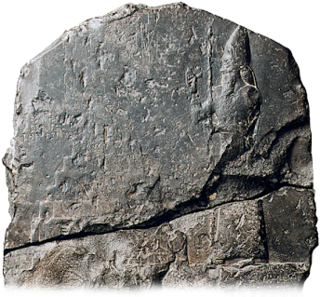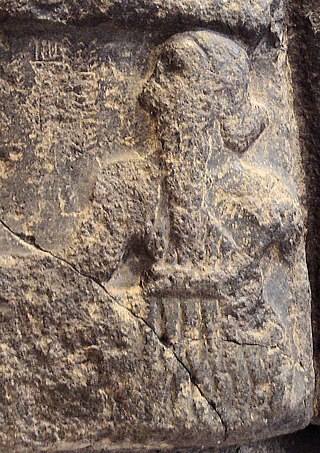Related Research Articles

Nebuchadnezzar II, also spelled Nebuchadrezzar II, was the second king of the Neo-Babylonian Empire, ruling from the death of his father Nabopolassar in 605 BC to his own death in 562 BC. Historically known as Nebuchadnezzar the Great, he is typically regarded as the empire's greatest king. Nebuchadnezzar remains famous for his military campaigns in the Levant, for his construction projects in his capital, Babylon, and for the important part he played in Jewish history. Ruling for 43 years, Nebuchadnezzar was the longest-reigning king of the Chaldean dynasty. At the time of his death, Nebuchadnezzar was among the most powerful rulers in the world.
Neriglissar was the fourth king of the Neo-Babylonian Empire, ruling from his usurpation of the throne in 560 BC to his death in 556 BC. Though unrelated to previous Babylonian kings, possibly being of Aramean ancestry, Neriglissar was a prominent official and general in the reign of Nebuchadnezzar II and became even more influential through marrying one of Nebuchadnezzar's daughters, possibly Kashshaya.

Belshazzar was the son and crown prince of Nabonidus, the last king of the Neo-Babylonian Empire. Through his mother, he might have been a grandson of Nebuchadnezzar II, though this is not certain and the claims to kinship with Nebuchadnezzar may have originated from royal propaganda.

Nabonidus was the last king of the Neo-Babylonian Empire, ruling from 556 BC to the fall of Babylon to the Achaemenid Empire under Cyrus the Great in 539 BC. Nabonidus was the last native ruler of ancient Mesopotamia, the end of his reign marking the end of thousands of years of Sumero-Akkadian states, kingdoms and empires. One of the most vibrant and individualistic rulers of his time, Nabonidus is remembered as the last independent king of Babylon, and he is characterised by some scholars as an unorthodox religious reformer and as the first archaeologist.

Amel-Marduk, also known as Awil-Marduk, or under the biblical rendition of his name, Evil-Merodach, was the third king of the Neo-Babylonian Empire, ruling from 562 BC until his overthrow and murder in 560 BC. He was the successor of Nebuchadnezzar II. On account of the small number of surviving cuneiform sources, little is known of Amel-Marduk's reign and actions as king.
Labashi-Marduk was the fifth and penultimate king of the Neo-Babylonian Empire, ruling in 556 BC. He was the son and successor of Neriglissar. Though classical authors such as Berossus wrote that Labashi-Marduk was just a child when he became king, Babylonian documents indicate that he had been in charge of his own affairs before his rise to the throne, suggesting he was an adult, though possibly still relatively young.

The Cyrus Cylinder is an ancient clay cylinder, now broken into several pieces, on which is written a declaration in Akkadian cuneiform script in the name of Persia's Achaemenid king Cyrus the Great. It dates from the 6th century BC and was discovered in the ruins of the ancient Mesopotamian city of Babylon in 1879. It is currently in the possession of the British Museum, which sponsored the expedition that discovered the cylinder. It was created and used as a foundation deposit following the Persian conquest of Babylon in 539 BC, when the Neo-Babylonian Empire was invaded by Cyrus and incorporated into his Persian Empire.

The Neo-Babylonian Empire or Second Babylonian Empire, historically known as the Chaldean Empire, was the last polity ruled by monarchs native to Mesopotamia. Beginning with the coronation of Nabopolassar as the King of Babylon in 626 BC and being firmly established through the fall of the Neo-Assyrian Empire in 612 BC, the Neo-Babylonian Empire was conquered by the Achaemenid Persian Empire in 539 BC, marking the collapse of the Chaldean dynasty less than a century after its founding.

The Chaldean dynasty, also known as the Neo-Babylonian dynasty and enumerated as Dynasty X of Babylon, was the ruling dynasty of the Neo-Babylonian Empire, ruling as kings of Babylon from the ascent of Nabopolassar in 626 BC to the fall of Babylon in 539 BC. The dynasty, as connected to Nabopolassar through descent, was deposed in 560 BC by the Aramean official Neriglissar, though he was connected to the Chaldean kings through marriage and his son and successor, Labashi-Marduk, might have reintroduced the bloodline to the throne. The final Neo-Babylonian king, Nabonidus, was genealogically unconnected to the previous kings, but might, like Neriglissar, also have been connected to the dynasty through marriage.
The Battle of Opis was the last major military engagement between the Achaemenid Persian Empire and the Neo-Babylonian Empire, which took place in September 539 BC, during the Persian invasion of Mesopotamia. At the time, Babylonia was the last major power in Western Asia that was not yet under Persian control. The battle was fought in or near the strategic riverside city of Opis, located north of the capital city of Babylon in modern-day Iraq, and resulted in a decisive victory for Persia. Shortly afterwards, the Babylonian city of Sippar surrendered to Persian forces, who then supposedly entered Babylon without facing any further resistance. The Persian king Cyrus the Great was subsequently proclaimed as the king of Babylonia and its subject territories, thus ending its independence and incorporating the entirety of the fallen Neo-Babylonian Empire into the greater Achaemenid Empire.

Sargon of Akkad, also known as Sargon the Great, was the first ruler of the Akkadian Empire, known for his conquests of the Sumerian city-states in the 24th to 23rd centuries BC. He is sometimes identified as the first person in recorded history to rule over an empire.

Anu or Anum, originally An, was the divine personification of the sky, King of the gods, and ancestor of many of the deities in ancient Mesopotamian religion. He was regarded as a source of both divine and human kingship, and opens the enumerations of deities in many Mesopotamian texts. At the same time, his role was largely passive, and he was not commonly worshiped. It is sometimes proposed that the Eanna temple located in Uruk originally belonged to him, rather than Inanna, but while he is well attested as one of its divine inhabitants, there is no evidence that the main deity of the temple ever changed, and Inanna was already associated with it in the earliest sources. After it declined, a new theological system developed in the same city under Seleucid rule, resulting in Anu being redefined as an active deity. As a result he was actively worshiped by inhabitants of the city in the final centuries of history of ancient Mesopotamia.
Erība-Marduk, inscribed mri-ba [dAMAR.UTU], was the king of Babylon, very speculatively ca. 769 – 761 BC. He was one of three Chaldaean tribal leaders to occupy the Babylonian throne during the course of the 8th century and would be looked back as the ancestor figure during future reigns of members of this group. A member of the Bīt-Yakin tribe, who was later to be given the title "re-establisher of the foundation(s) of the land," he was credited with restoring stability to the country after years of turmoil.
The ancient Mesopotamian deity Bunene, inscribed in cuneiform sumerograms as dḪAR and phonetically as dbu-ne-ne, was a subordinate to and sukkal ("vizier") or charioteer of the sun-god Šamaš, whom he drove from the eastern horizon at dawn to the doorway of the interior of heaven in the west at dusk in a daily ritual. Like his overlord Šamaš, Bunene had a sanctuary, the é.kur.ra, or "House of the Mountain", at Sippar, modern Abu Habbah which was rebuilt by Nabonidus, the last king of the Neo-Babylonian Empire and he also featured in the pantheons at Uruk and Larsa, where his patron was also venerated.

The Babylonian revolts of 484 BC were revolts of two rebel kings of Babylon, Bel-shimanni and Shamash-eriba, against Xerxes I, king of the Persian Achaemenid Empire.

The Harran Stela was discovered in 1956 in the ruins of Harran, in what is now southeast Turkey. It consists of two parts, both of which show, at the top, Nabonidus worshipping symbols of the Sun, Ishtar, and the moon-god Sin. The stela is significant as a genuine text from Nabonidus that demonstrates his adoration of these deities, especially of Sin, which was a departure from the traditional Babylonian exaltation of Marduk as the chief god of the heavenly pantheon. According to Paul-Alain Beaulieu, the Stela was composed in the latter part of his reign, probably the fourteenth or fifteenth year, i.e. 542–540 BC.
Uṣur-amāssu was a Mesopotamian deity. While originally viewed as male, she later came to be regarded as a goddess. Regardless of gender, Uṣur-amāssu was considered as a child of Adad and Shala and like other members of their entourage was considered a deity of justice. The earliest attestations of veneration of Uṣur-amāssu are theophoric names from cities such as Kish, but the female version of this deity is best attested in sources from Uruk from the Neo-Babylonian period. She belonged to the pentad of goddesses who stood on top of the local pantheon, which also included Ishtar, Nanaya, Bēltu-ša-Rēš and Urkayītu. She is still attested in texts from the Seleucid period, and continued to be celebrated during an akitu festival.

Annunitum or Anunītu was a Mesopotamian goddess of war. While initially she functioned as an epithet of Ishtar, she started to develop into a separate deity in the final years of the Sargonic period and through the Ur III period.
Ulmašītum was a Mesopotamian goddess regarded as warlike. Her name was derived from (E-)Ulmaš, a temple in the city of Akkad dedicated to Ishtar. She was commonly associated with Annunitum, and in many texts they appear as a pair. While she originated in northern Mesopotamia, in the Ur III period she is best attested in Ur, though later she was also worshiped in Malgium.
References
- ↑ Faculty directory Archived 2014-01-22 at the Wayback Machine , Near and Middle Eastern Civilizations, Univ. of Toronto, retrieved 2011-05-03.
- 1 2 List of completed masters' theses in history, Univ. de Montréal, retrieved 2011-05-03 (in French).
- ↑ Thesis date as cited by Hallo, William W. (2010), The world's oldest literature: studies in Sumerian belles-lettres, Culture and history of the ancient Near East, vol. 35, Brill, p. 609, ISBN 978-90-04-17381-1 .
- ↑ Publisher's biography for his book Legal and Administrative Texts from the Reign of Nabonidus; faculty listing from Harvard student handbook, Fall 2010.
- ↑ Review of The Reign of Nabonidus by David W. Suter (1992), The Biblical Archaeologist55 (4): 234–235, JSTOR 3210321.
- ↑ Review of The Reign of Nabonidus by David B. Weisberg (1991), Critical Review of Books in Religion4: 103–105.
- ↑ Review of Legal and Administrative Texts by M. A. Dandamayev (2001), Journal of the American Oriental Society121 (4): 700–702, JSTOR 606539.
- ↑ Review of The Pantheon of Uruk by Robert D. Biggs (2006), Journal of Near Eastern Studies65 (2): 141–143, doi : 10.1086/504999.
- ↑ Review of The Pantheon of Uruk by M. A. Dandamayev (2004), Journal of the American Oriental Society124 (1): 155–157, JSTOR 4132182.
- ↑ Review of The Pantheon of Uruk by John MacGinnis (2005), Zeitschrift für Assyriologie und vorderasiatische Archäologie95: 303–306.
- ↑ http://www.academia.edu & utoronto.academia.edu